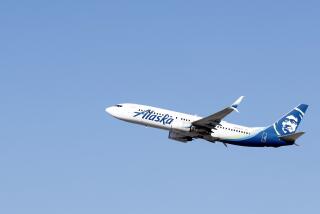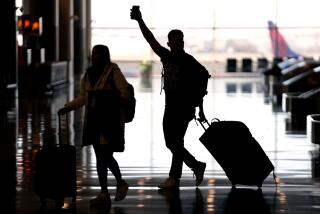Foreign Airlines Using U.S. Airports: Safety Gap : Travel: Dozens of times in the last five years, language difficulties and other problems have created frightening incidents and near collisions, records show.
In the high-altitude corridor above Bimini, the Boeing 727 flown by Aerolineas Centrales de Colombia was just one of seven jets stacked for the approach to Miami one day last February.
But what should have been a routine approach for ACES Flight 500 turned quickly into a near disaster.
The controller told the Colombian crew to stay put at 26,000 feet and watch for nearby traffic: “ACES 500, maintain flight level two six zero, and you can expect lower passing traffic . . . turning northbound is a Navy P3, flight level two five zero.”
Instead, pilot’s response indicated a change of course--a collision course: “ACES 500, descending two five zero.”
The controller soon realized she had a plane full of passengers converging on the Navy craft at 300 m.p.h. at the same altitude. She quickly radioed: “ACES 500, turn left, fly heading two two zero. Turn left NOW!” Disaster was averted by a margin of four miles, or about 40 seconds, the Federal Aviation Administration later estimated.
“There appeared to be a problem with the pilot’s English,” said Gary Perkins, an FAA flight standards specialist in Miami who ordered the airline to review its English proficiency program.
The incident is not an isolated one. Dozens of times in the last five years, language difficulties and other problems have created frightening incidents and near collisions between foreign and U.S. carriers, according to federal records obtained by Newsday.
Five years after the crash of a Colombian jetliner on a Cove Neck, N.Y., hillside exposed problems in foreign airline safety--including lapses in communication and training--many of the difficulties remain. The Avianca flight crashed when it ran out of fuel after being delayed in bad weather along the U.S. East Coast.
Based on a computer study, federal records and interviews, Newsday found little improvement in foreign airline safety since the 1990 crash.
The safety gap between U.S. airlines and foreign airlines remains huge, even though the record of foreign carriers has improved, while U.S. carriers’ declined slightly. The odds of dying on a foreign flight were still several times greater than on a U.S. carrier.
Other safety recommendations that grew out of the 1990 crash were rejected, or are languishing in bureaucratic channels. A new rule that is more specific about declaring fuel emergencies--a failing cited as a major cause of the Avianca crash in 1990--still has not been approved and implemented by international authorities.
The FAA has been reluctant to crack the whip over foreign airlines, even though officials acknowledge that many have dismal safety records. Under prodding by Congress, the agency began to take a stronger hand in overseeing foreign airlines--13 countries have had their airlines banned or put on probation. But the General Accounting Office has criticized the FAA for being overly timid. And the FAA was slow to take action against a Mexican carrier grounded by Canadian authorities in 1992.
“We really don’t think they’ve done enough,” said David Stempler, director of the International Airline Passengers Assn., a watchdog group that has warned members of the dangers of flying in Colombia and other countries. “They’ve given a clean bill of health to Colombia--and to Russia, one country that’s really questionable.”
But FAA officials say they’re making progress. “We think we’ve improved safety,” said Tim Neel, the director of the FAA’s international office, which oversees the assessment of foreign aviation authorities. Although it is impossible to measure, Neel said, “We’re hoping that by getting them up to standard, we’ll improve it all over the world.”
Foreign airline safety is a critical issue to many U.S. travelers. More Americans are traveling abroad on non-U.S. carriers--more than 17 million Americans flew foreign carriers in 1993, up from 15.5 million in 1989. Many of those fly on airlines--such as Lufthansa, British Airways and SAS--that have safety records at least as good as U.S. carriers.
But millions also fly on airlines with seriously questionable records. The chance of dying on a U.S. airliner was about one in 8.1 million during the 10-year period 1985-94, up from one in 13.3 million during the period 1980-89. Aboard foreign airlines, the chance of dying was one in 1.1 million in the most recent 10-year period, down from one in 980,000.
And a group of 35 airlines--including Avianca--that was found to be the most dangerous when examined after the Avianca crash has not improved much. The chance of dying was about one in 300,000 for them during both 10-year periods, Newsday’s analysis shows.
Newsday’s calculations of aviation safety records are based on a database of more than 900 accidents worldwide since 1969. A statistical probability of dying on any given flight is calculated for more than 200 major, internationally registered airlines by comparing their crash records to number of flights, when available. Newsday used 10-year periods to minimize fluctuations in the data. The analysis shows that 13 U.S. airlines have accounted for about half of the world’s flights, but only about 10% of the accidents.
The study does not include several airlines that could be the world’s most dangerous. Traffic statistics are not available for the Russian carrier Aeroflot, the Chinese national carriers, or China Airlines of Taiwan, which together have accounted for 91 reported accidents in the last 25 years.
Foreign airplanes can pose hazards to the safety of passengers on other flights even when they aren’t flying on them. Newsday reviewed dozens of reports of accidents, incidents and near misses involving foreign airlines over the last five years, and found continuing mix-ups and mistakes.
Carriers from South America and Africa were the focus of an FAA investigation ordered by Congress in 1991. The agency looked at 30 countries, and found that nine had virtually no safety oversight. They banned the nations’ airlines not already flying into the United States from starting flights to this country, and put carriers from another four countries under heightened inspections.
But it wasn’t enough, the GAO concluded in 1992. The FAA action was fine as far as it went, but the FAA did not inspect airlines from those countries that were already flying to the United States.
The FAA’s assessment of foreign regulations may have resulted in the banning of some airlines, but it also gave a clean bill of health to countries such as Colombia that have safety regulations on the books--but still have bad safety records.
More to Read
Sign up for Essential California
The most important California stories and recommendations in your inbox every morning.
You may occasionally receive promotional content from the Los Angeles Times.










